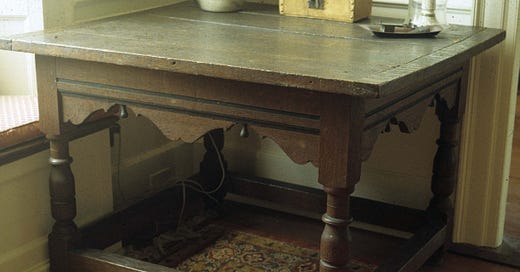I’m at the beginning stages of making a joined chest with a drawer - just splitting and planing the stock. That then has to sit and dry some before I go onto the next steps. In the meantime, I’m working on the last steps in making a large joined table. As I’ve been thinking about the table project, I realized that tables are a new subject for this blog. (maybe - I can’t keep track of whether I’ve discussed them here or not…)
Seventeenth-century tables come in a few forms. Like most anything else, they can range from plain to elaborate. Mine fall in between. I ran through some of the probate inventory references I have from New England. Some descriptors are not much use to us when we’re trying to understand what sort of table the appraisers were seeing. “Old”, “small”, - these things don’t help much. “Long” is a little better, “joined” is helpful. One phrase that’s very common is a “square table” seen in many period inventories. In that case, square is an approximate adjective - it means a table that’s generally square as opposed to rectangular or round. I’ve made them over the years, they’re nearly always the same general size - the frames are about 3’ square, more or less. Only one of the square tables I’ve studied has its original top - this one (above) made in Newbury Massachusetts and now in the Historical Society of Old Newbury. Its frame is 28 1/2” high and 32 7/8” x 35 3/4”. The top overhangs 2” on two sides, 3” on the other two. So the top is about 38 7/8” x 39 3/4.” Pretty close to square.
My notes on that table are from June 1993 - I think I’ve only seen it in once since then and that was in passing. It’s all oak, all mortise & tenon. Like an overgrown joined stool. Its aprons have brackets all around - these and the stretchers mean you don’t tuck under this table like we’re used to doing today. Even if you rested your feet on the stretchers, you couldn’t tuck your legs under the aprons’ brackets. I think you side at/beside this table.
Those brackets are separate - those at the corners are tenoned into the stiles and nailed up to the bottom edge of the apron. I forget how the middle ones are attached. These scans are from slides - at the time, I was fixated on the hewn & riven texture under the multi-board top and inside the aprons.
Another square table is this one at Shelburne Museum in Vermont. Its top is gone and the table is displayed just as the frame. That allows for great views into its construction.
These brackets are integral to the aprons - they’re pitched at an angle, then cut out. A molding separates the flat part of the rail from the angled part that becomes the brackets.
Keep reading with a 7-day free trial
Subscribe to Follansbee's Substack to keep reading this post and get 7 days of free access to the full post archives.







